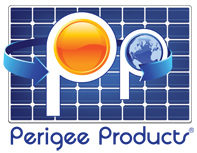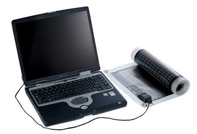THE COMPANY

Founded in 1998, Perigee Products, Inc. is a privately held Nevada-based manufacturer and retailer of solar-powered consumer products.
The company was originally started during the Dot Com Boom as SolarFlare.com, a website that offered a wide range of novelty items that were powered by solar energy – toys, fans, flashlights, radios, mosquito repellers, etc. It was a typical reseller model that entailed importing products from China and Taiwan, marking them up and selling them exclusively over the Internet. The site crashed and burned in 2000, but the founders – Mark Naismith and Gary Nakamura, buddies from the Graduate School of Business at Stanford – had friends in the VC world, had made some good connections on the manufacturing end, and decided to retool the business.
They leased a 150,000-square-foot warehouse in Carver Park, about 25 miles southeast of Las Vegas, brought in a renowned solar engineer who held several patents on photovoltaic wafer technology, and began producing solar products of their own under the Perigee brand – named for the position of the sun when it is closest to Earth’s orbit.
- PRODUCTS
- EARLY DAYS
- RETAIL STORES

Perigee’s first – and to date, still most successful – product is a line of stylish solar-powered landscape lights. The lights come with pivoting heads that allow the consumer to position the lights in such a way as to maximize the intake of sunlight, while still directing the light straight down. The lights are sold primarily through Home Depot, earning a steady stream of revenue for Perigee. But, learning from some of the mistakes of SolarFlare.com, Perigee now also makes many products that would be considered far more practical. There are solar-powered water filtration systems, solar panels for notebook computers, portable solar-powered refrigerator/freezers for camping – even solar-powered landscaping equipment like hedge-clippers, string-trimmers and lawnmowers. All of these products are assembled at the Carver City plant, using solar wafers made on site, although other parts are imported from around the world.
The company was reasonably well capitalized from the start, after two rounds and $58 million of fundraising. In the first three years as Perigee, they ran an operating deficit that was sometimes as large as $1 million a month. But the contract with Home Depot started to pay off in 2005, throwing off enough cash to cut the gap and bring the company to the verge of break-even on $95 million in sales.
In 2006, the company had its first profitable year, and decided to move forward with the creation of two retail stores, daringly called “Solar
Flair,” and featuring a selection of its most stylish and practical products.
You were put in charge of the Retail Division, and opened the first store in nearby Henderson, NV in the third quarter of 2007 to considerable fanfare and better-than-expected sales (Las Vegas was never considered to have great long-term potential for this kind of store). The store ran very lean, with minimal labor, and projections showed that it might actually turn a profit before the end of year two. Based on that early success, Perigee moved quickly to open a second store in 2008 in San Diego, securing a great location in the Fashion Valley Center Mall by signing an expensive15-year lease with strict covenants. Because most of the Board members live in San Diego, Mark actually hired his brother to run that store. Two more leases were signed in the LA market, which is considered to be the most lucrative market for solar products in the country, and those stores were expected to open before the holiday season in 2009.
In 2007, total company sales topped $150 million for the first time, and Perigee earned $3.4 million in profits. You got the San Diego store open in April of 2008. By the end of 2008 there were 258 employees, mostly in manufacturing and engineering, but also including 26 in your Retail Division.
Solar photovoltaic (PV) devices generate electricity directly from sunlight via an electronic process that occurs naturally in certain types of material, called semiconductors. Electrons in these materials are freed by solar energy and can be induced to travel through an electrical circuit, powering electrical devices or sending electricity to the grid. PV devices can be used to power anything from small electronics such as calculators and road signs up to homes and large commercial businesses.
Development of the Solar Industry
The energy crisis of the 1970s saw the beginning of major interest in using solar cells to produce electricity in homes and businesses, but prohibitive prices (nearly 30 times higher than the current price) made large-scale applications impractical.
The cost of PV has dropped dramatically as the industry has scaled up manufacturing and incrementally improved the technology with new materials. Installation costs have come down, too, with more experienced and trained installers. Globally, the US is the fourth largest market for PV installations behind world leaders Germany, Japan and Spain.
Manufacturing
.jpg)
Most modern solar cells are made from either crystalline silicon or thin-film semiconductor material. Silicon cells are more efficient at converting sunlight to electricity, but generally have higher manufacturing costs. Thin-film materials typically have lower efficiencies, but are simpler and less costly to manufacture.



.jpg)